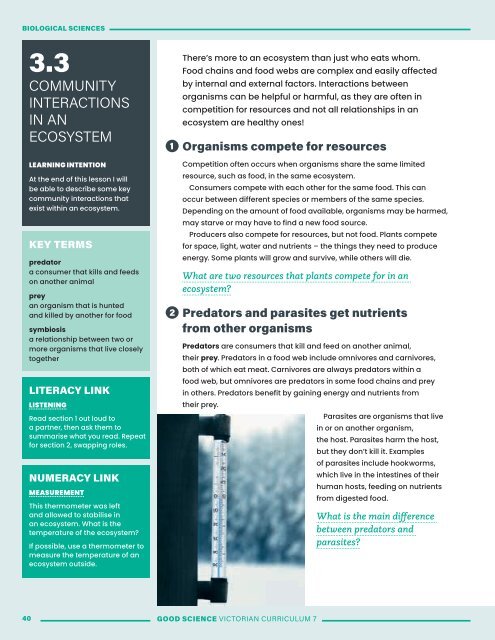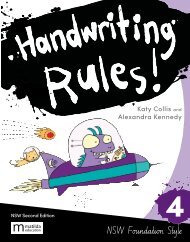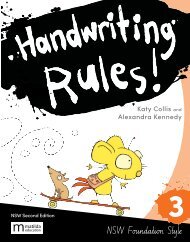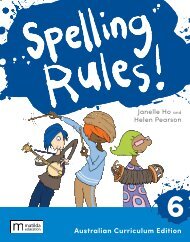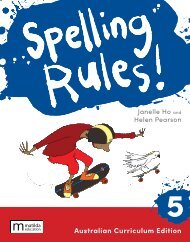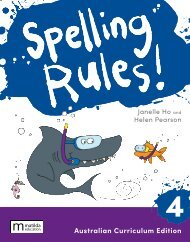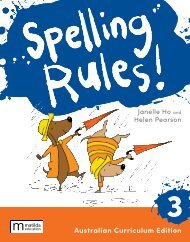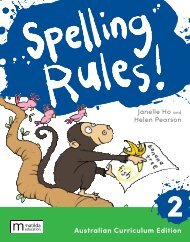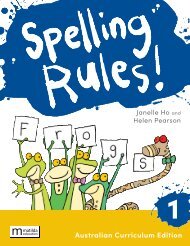Good Science Victorian Curriculum Year 7
Digital sample of Matilda's newest publication, Good Science Victorian Curriculum Year, authored by Emma Craven and Aaron Elias. For more information visit www.matildaeducation.com.au or email Katrina Tucker, katrinatucker@matildaed.com.au
Digital sample of Matilda's newest publication, Good Science Victorian Curriculum Year, authored by Emma Craven and Aaron Elias. For more information visit www.matildaeducation.com.au or email Katrina Tucker, katrinatucker@matildaed.com.au
You also want an ePaper? Increase the reach of your titles
YUMPU automatically turns print PDFs into web optimized ePapers that Google loves.
BIOLOGICAL SCIENCES<br />
3.3<br />
COMMUNITY<br />
INTERACTIONS<br />
IN AN<br />
ECOSYSTEM<br />
LEARNING INTENTION<br />
At the end of this lesson I will<br />
be able to describe some key<br />
community interactions that<br />
exist within an ecosystem.<br />
KEY TERMS<br />
predator<br />
a consumer that kills and feeds<br />
on another animal<br />
prey<br />
an organism that is hunted<br />
and killed by another for food<br />
symbiosis<br />
a relationship between two or<br />
more organisms that live closely<br />
together<br />
LITERACY LINK<br />
LISTENING<br />
Read section 1 out loud to<br />
a partner, then ask them to<br />
summarise what you read. Repeat<br />
for section 2, swapping roles.<br />
NUMERACY LINK<br />
MEASUREMENT<br />
This thermometer was left<br />
and allowed to stabilise in<br />
an ecosystem. What is the<br />
temperature of the ecosystem?<br />
If possible, use a thermometer to<br />
measure the temperature of an<br />
ecosystem outside.<br />
1<br />
2<br />
There’s more to an ecosystem than just who eats whom.<br />
Food chains and food webs are complex and easily affected<br />
by internal and external factors. Interactions between<br />
organisms can be helpful or harmful, as they are often in<br />
competition for resources and not all relationships in an<br />
ecosystem are healthy ones!<br />
Organisms compete for resources<br />
Competition often occurs when organisms share the same limited<br />
resource, such as food, in the same ecosystem.<br />
Consumers compete with each other for the same food. This can<br />
occur between different species or members of the same species.<br />
Depending on the amount of food available, organisms may be harmed,<br />
may starve or may have to find a new food source.<br />
Producers also compete for resources, but not food. Plants compete<br />
for space, light, water and nutrients – the things they need to produce<br />
energy. Some plants will grow and survive, while others will die.<br />
What are two resources that plants compete for in an<br />
ecosystem?<br />
Predators and parasites get nutrients<br />
from other organisms<br />
Predators are consumers that kill and feed on another animal,<br />
their prey. Predators in a food web include omnivores and carnivores,<br />
both of which eat meat. Carnivores are always predators within a<br />
food web, but omnivores are predators in some food chains and prey<br />
in others. Predators benefit by gaining energy and nutrients from<br />
their prey.<br />
Parasites are organisms that live<br />
in or on another organism,<br />
the host. Parasites harm the host,<br />
but they don’t kill it. Examples<br />
of parasites include hookworms,<br />
which live in the intestines of their<br />
human hosts, feeding on nutrients<br />
from digested food.<br />
What is the main difference<br />
between predators and<br />
parasites?<br />
40 GOOD SCIENCE VICTORIAN CURRICULUM 7


